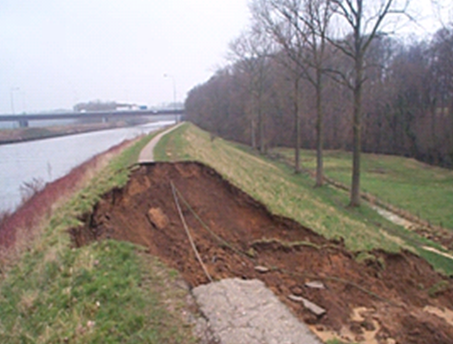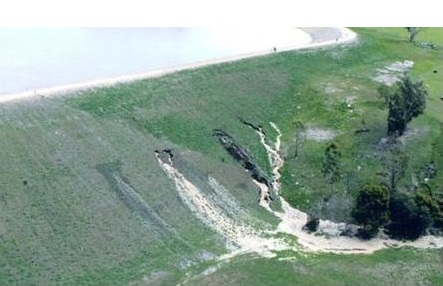-
Notifications
You must be signed in to change notification settings - Fork 61
Tutorial Manual Introduction
Interactions between soil, water, and structures play an important role in geotechnical, environmental and civil engineering problems, such as landslides induced by seepage and rain, liquefaction or fluidisation, and sedimentation processes in submerged slopes, internal erosion in dykes, scouring around offshore structures, consolidation-induced settlement or pile installation in saturated soils. In many cases, the material involved can experience large deformations, which can lead to dramatic events. The numerical modelling of these processes is challenging because the treatment of soil-water coupling, soil-structure interaction, and large deformations is not straightforward.
MPM is a point-based numerical method capable of modelling large deformations, which has been extended and implemented in the Anura3D software to cope with advanced soil-water-structure interaction problems. This tutorial manual provides instructions on how to perform numerical simulations with Anura3D. More detailed information on the material point method and its applications is given by Fern et al. (2019). A list of publications and the Anura3D Scientific Manual are also good references available on the Anura3D website.


The Anura3D Software is being developed by the Anura3D MPM Research Community. In this international collaboration the complementary expertise of different groups that carry out research on numerical modelling of large deformations and soil--water--structure interaction is brought together. For more information visit the Anura3D website.
The Anura3D MPM Research Community is collaborating with CIMNE (International Center for Numerical Methods in Engineering), who is granting free temporal licences of GiD for the academic purposes of the Anura3D MPM Research Community. The support of CIMNE is greatly acknowledged. The Anura3D MPM Research Community uses GiD to develop the Anura3D "problemtype". GiD may also be used as a pre-processing software for the preparation of the required files to perform calculations with Anura3D. However, the interface between Anura3D and the pre- and post-processing software is completely open and the user may choose other software.
Anura3D is a research-oriented software developed by the Anura3D MPM Research Community. The code has been validated and tested with a limited number of problems. The Anura3D MPM Research Community shall not be responsible for losses of any kind resulting from the use of this program. Anura3D is a free open source software under the GNU Lesser General Public License version 3.
The most relevant publications related to the development and application of the Anura3D software are available online where direct links to the respective journals or theses for download are provided. The development of the current code started in 2008 and is ongoing.
The features implemented in the open source are briefly summarized in Table 1.1. While some of them have been tested, others are still under development. The examples provided in this tutorial provide guidance to the user through the available tested features.
Table 1.1: List of features available in Anura3D 2023
| Name of the Feature | Under development | Tested |
|---|---|---|
| Geometrical dimensions | ||
| 2D plane-strain | X | |
| 2D axisymmetric | X | |
| 2D cartesian | X | |
| 3D cartesian | X | |
| 3D cylindrical | X | |
| Computational methods | ||
| MPM-MP | X | |
| MPM-MIXED | X | |
| UL-FEM | X | |
| FEM | X | |
| Integration schemes | ||
| Explicit | X | |
| Implicit | X | |
| Multiphase formulations | ||
| 1-phase (dry material, undrained, drained) | X | |
| 2-phase single-point for saturated soil | X | |
| 2-phase single-point for unsaturated soil | X | |
| 2-phase double-point | X | |
| 3-phase single-point | X | |
| Constitutive models | ||
| Linear elastic | X | |
| Mohr-Coulomb | X | |
| Bingham fluid | X | |
| External soil model (user defined) | X | |
| Other features | ||
| Contact algorithm | X | |
| Moving mesh | X | |
| Excavation | X | |
| Rigid body | X | |
| Bulk viscosity | X | |
| Submerged analysis | X | |
| Output of reaction forces at surfaces | X | |
| Boundary and initial conditions | ||
| Traction/pressure | X | |
| Infiltration & evaporation | X | |
| Total hydraulic head | X | |
| Seepage force | X | |
| Absorbing boundary | X | |
| Remove fixity | X | |
| Prescribed velocity | X | |
| Initial velocity on material points | X | |
|
|
X | |
| Stress initialization with quasi-static convergence | X |
The current state of the Anura3D has the following identified limitations concerning the tested features:
- 3D-Cylindrical: y-axis is the axis of symmetry, gravity can only be applied in y-axis direction.
- Multiphase formulations: a combination of different material types can cause problems for certain combinations (undrained total stress and undrained effective stress), no water flow is transferred between saturated and dry materials.
- Contact algorithm: the maximum number of contact materials is four (4), the maximum number of master materials is one (1). Contact is fixed on the mesh nodes.
- Moving mesh: works only for prismatic bodies in 3D and trapezium areas in 2D, the moving mesh direction is constrained only in one direction. the moving mesh needs an extension and/or compression mesh.
- Excavation: limited to 30 excavation stages.
- Rigid body: can be applied only to one body in the system, only works together with the contact algorithm, only moves in one direction, it can’t rotate.
- Fixities and traction boundary conditions: only aligned with the coordinate axes
-
$K_0$ stress initialization: one homogeneous material (otherwise, use gravity together with local damping and stress initialization with quasi-static convergence criteria). -
Infiltration/evaporation boundary condition: only one value of infiltration rate can be applied, it is not possible to assign different values at different part of the domain. If two-phase single point unsaturated formulation is used,
$K_0$ initialization works if a phreatic surface and a soil surface are specified using options available in Anura3D_2023 Problem Type. Phreatic surface and soil surface are assigned to lines, thus are only limited to 2D geometries.
The user should take into account the following warnings:
- Multiple materials: the use of several drainage material types on the same model is not recommended.
- Absorbing boundaries: do not prevent material points from leaving the mesh.